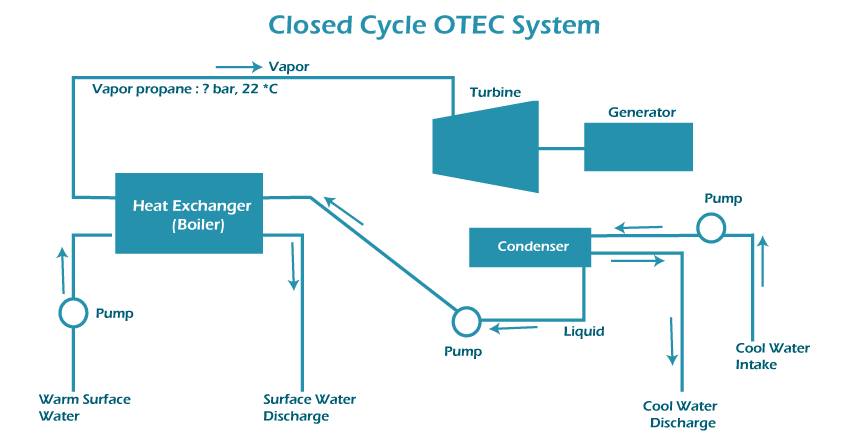Island Nations, being geographically unique, often need help with numerous energy security and sustainability challenges. The most common issue that island nations suffer from is the shortage of land, and as a result, they have no space to build and maintain energy generation facilities. As they rely on imported fossil fuels to provide energy, island nations are also subject to uncertainties in the energy supply. In addition, the fact that most island nations are located in areas with high natural disaster risk increases their vulnerability. Due to the above reasons, the Ocean Thermal Energy Conversion process can be viewed as a possible solution to the problem.
Ocean Thermal Energy Conversion (OTEC) is a renewable energy technology that involves different temperatures of water on the surface of the ocean. Particularly, a fluid with a low boiling point is used to boil the water on the ocean surface; the steam that forms as a result rises and then gets cold and turns into water again after contact with the cold ocean water. A turbine is activated as a result, and electricity is produced. This process has specific implications as far as the role of island nations in the OTEC process is concerned and is especially beneficial for the economies of island nations.

Why OTEC is Ideal for Islands
Abundant Resource: Island nations often display consistent and temperate climates year-round. The vast ocean hemisphere surrounding an island can be conducive to the operation of an OTEC plant. As operating the plant requires the temperature gradient between the warm surface and the cool deep water of the ocean, higher temperature differentials result in a more efficient OTEC operation. Thus, if an island nation has such insolation, it is a perfect place to set up an OTEC system.
Renewable Energy: The fact that the ocean, regardless of weather and time, is never-ending and infinite means that there is an unlimited supply of thermal energy to be harnessed from the ocean. Thus the efficiency and power output of the plant are predictable and can run consistently without any interruptions.
Reduced Dependency on Fossil Fuels: Unlike traditional sources of energy, such as coal, oil, or gas, heat from the sun changes ocean temperature continuously twice a day. Harnessing the difference in these temperatures as a possible source of energy never runs out, and since heat does not take an excessively long time to transition between ocean temperatures, it makes it an infinite source.
Environmental Benefits: One of the most significant benefits of using OTEC, especially in small developing island nations, is that it is a renewable resource that does not release greenhouse gases that create air pollution. It can be used to produce fresh water through desalination. Additionally, by reducing pollution, OTEC can lead to fewer funds spent on cleaning polluted water and the atmosphere, offsetting some of the high associated costs required to initiate the use of this resource.
Economic opportunities: Ongoing investment in technology would lead to new job openings for the island communities.
Challenges with Ocean Thermal Energy Conversion
While the advantages of OTEC use are considerable, there are significant challenges that may prevent small developing island nations from adopting OTEC:
High Capital Costs: The relatively high capital costs required to set up the technology are likely to slow the process. That being said, OTEC is bound to evolve, and the increases in scale at which it is produced are likely to reduce its prices.
Temperature Gradient Requirements: The most evident limitation of OTEC operation is the requirement of a large temperature difference between the surface waters of the ocean and its depth. It means that the availability of this technology in some areas may be impaired due to the absence of the required conditions.
Environmental Impacts: The discharge of large volumes of cooler, nutrient-rich water from OTEC facilities into the ocean could potentially have significant impacts on marine biota and ecosystem dynamics, which require further investigation The discharge of water from OTEC facilities can lead to impingement and entrainment of marine organisms, while biocide treatments and electromagnetic fields may also have negative impacts on marine ecosystems.
Grid Integration: Large-scale OTEC systems must generate electricity that can be easily integrated into existing power grids. Otherwise, the integration might not be cost-effective, or even logistically and technically feasible.
To overcome the challenges that impede the deployment of OTEC and its integration into energy efforts, it is important to focus on reducing costs by developing new methods and technologies. In addition, technologies that can support the difference between the temperatures and that do not rely on the difference between warm and cold seawater should be developed. To achieve the diffusion of OTEC, funding must also be provided to encourage the development of the technology and to work toward implementing diffused electricity in island nations.
Conclusion
Ocean thermal energy conversion is the mainstream solution for island nations to address their energy security and sustainability issues. Harnessing the substantial energy available from the difference in temperature between the ocean’s warmer surface and cold deep waters, this renewable and clean source of electricity will provide power to regions most in need. Although there are challenges to address, including high capital costs and notable environmental effects, the existing body of research and development topics is aimed at mitigating them.

